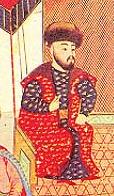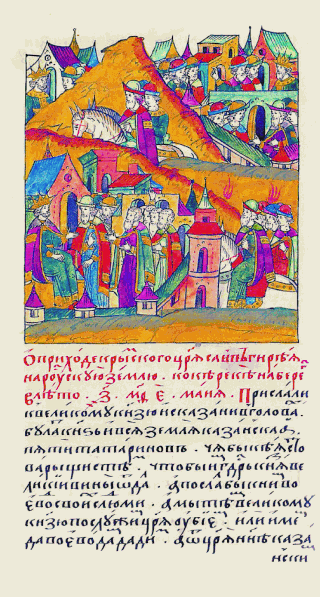Related Research Articles

The Crimean Khanate, self-defined as the Throne of Crimea and Desht-i Kipchak, and in old European historiography and geography known as Little Tartary, was a Crimean Tatar state existing from 1441–1783, the longest-lived of the Turkic khanates that succeeded the empire of the Golden Horde. Established by Hacı I Giray in 1441, it was regarded as the direct heir to the Golden Horde and to Desht-i-Kipchak.

Ghabdellatif was the Khan of the Kazan Khanate from 1496 to 1502.
Hacı I Giray (1397–1466) was the founder of the Crimean Khanate and the Giray dynasty of Crimea ruling from c. 1441 until his death in 1466. As the Golden Horde was breaking up, he established himself in Crimea and spent most of his life fighting off other warlords. He was usually allied with the Lithuanians. His name has many spellings, such as Haji-Girei and Melek Haji Girai.

Devlet I Giray ruled as Crimean Khan during a long and eventful period marked by significant historical events. These events included the fall of Kazan to Russia in 1552, the fall of the Astrakhan Khanate to Russia in 1556, and the burning of Moscow by the Crimean Tatars in 1571. Another notable event during Devlet's reign was the defeat of the Crimeans near Moscow in 1572. However, Cossack raids into the Crimea were also common during his reign.
Hayder Khan Giray was either once or twice briefly a Khan of Crimea.

Gazaria was the name given to the colonial possessions of the Republic of Genoa in Crimea and around the Black Sea coasts in the territories of the modern regions of Russia, Ukraine and Romania, from the mid-13th century to the late 15th century. The Genoese rule was represented by a consul, and the capital of the Gazaria was the city of Kaffa in the Crimean peninsula.

Chufut-Kale is a medieval city-fortress in the Crimean Mountains that now lies in ruins. It is a national monument of Crimean Karaites culture just 3 km (1.9 mi) east of Bakhchysarai.

The Great Horde was a rump state of the Golden Horde that existed from the mid-15th century to 1502. It was centered at the core of the former Golden Horde at Sarai on the lower Volga.

Bikhakhanim, was the reigning princess of a small polity located on the Taman Peninsula in southern Russia.

The Taman Peninsula is a peninsula in Krasnodar Krai, Russia, which borders the Sea of Azov to the north, the Kerch Strait to the west and the Black Sea to the south.

Meñli I Giray (1445–1515) was thrice the khan of the Crimean Khanate and the sixth son of Hacı I Giray.
Khozi Kokos is the name given in Russian sources for an advisor to Ivan III of Muscovy. Khozi Kokos was a Jew, probably a native of Caffa in Genoese-occupied Gazaria. His name is likely Turkic; "Khozi" may derive from the word for "pilgrim", and "Kokos" may derive from the Turkic "Kök Koz", or "Blue-Eyed". The Turkic name suggests that he may have been a Krymchak or Karay; Khazar descent is not out of the question but no sources refer to contemporary surviving Khazar communities.

The Fire of Moscow occurred on 24 May 1571, when the Crimean army led by the khan of Crimea Devlet I Giray, bypassed the Serpukhov defensive fortifications on the Oka River, crossed the Ugra River into the Moscow suburbs, and rounded the flank of the 36,000–40,000 men of the Russian army.

The Russo-Kazan Wars were a series of short, intermittent wars fought between the Grand Principality of Moscow and the Khanate of Kazan between 1437 and 1556. Most of these were wars of succession in Kazan, in which Muscovy intervened on behalf of the dynastic interests of its main ally, the Crimean Khanate. For most of the period, neither side sought to conquer the other, until Ivan the Terrible decided to annex Kazan upon the successful 1552 siege, which was followed by a rebellion lasting until 1556.

Sahib I Giray (1501–1551) was Khan of Kazan for three years and Khan of Crimea for nineteen years. His father was the Crimean Khan Meñli I Giray. Sahib was placed on the throne of Kazan by his ambitious brother Mehmed of Crimea and driven out of Kazan by the Russians. He became Khan of Crimea with Ottoman support and was expelled by the Turks for disobedience. During his reign Crimean troops fought for the Turks and also fought in the North Caucasus. In 1532-1584, during the long reigns of Sahib I Giray, Devlet I Giray and Mehmed II Giray, Crimea was at the height of its power.

Crimean–Nogai slave raids in Eastern Europe were the slave raids, for over three centuries, conducted by the military of the Crimean Khanate and the Nogai Horde primarily in lands controlled by Russia and Poland-Lithuania as well as other territories, often under the sponsorship of the Ottoman Empire, which provided slaves for the Crimean and Ottoman slave trades.
Nur Devlet Giray was the khan of the Crimean Khanate from 1466 to 1467, 1467 to 1469, and 1475 to 1476. He was a son of Hacı I Giray, the founder of Crimean Khanate.

Bilhorod-Dnistrovskyi fortress or Akkerman fortress is a historical and architectural monument of the 13th–14th centuries. It is located in Bilhorod-Dnistrovskyi in the Odesa Oblast of southwestern Ukraine, the historical Budjak.
The Genoese–Mongol Wars were a series of conflicts fought between the Republic of Genoa, the Mongol Empire and its successor states, most notedly the Golden Horde and Crimean Khanate. The wars were fought over control of trade and political influence in the Black Sea and Crimean peninsula during the 13th, 14th and 15th centuries.
